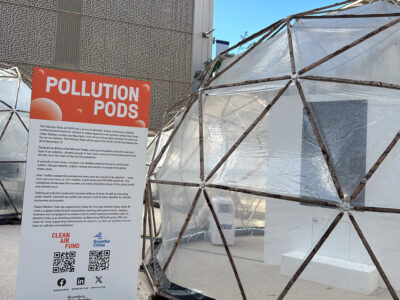public health
Lives in the Balance: Infectious Disease and the Trump Administration
The Administration has made serious inroads on safeguards against infectious disease.
Disease control, like many other traditional government activities, has been under a MAGA-driven onslaught. Indeed, we cannot rule out the risk that rather than helping, the government will try to block the use of lifesaving vaccines.
CONTINUE READINGNew Environmental Laws Focus on Public Health
Many of the environmental-focused bills that the governor signed this year involve ways to alleviate the health disparities faced by frontline communities.
The California State Legislature is now finally in its off-season. Governor Newsom had until Monday, September 30th to sign or veto bills that the legislature passed and sent to his desk. In a final tally of bills, according to CalMatters, Governor Newsom vetoed approximately 18% of the nearly 1,000 bills that landed on his desk …
Continue reading “New Environmental Laws Focus on Public Health”
CONTINUE READINGDid the COVID Response Poison the Well for Climate Action?
Sadly, the answer may be yes, at least for one conspiracy-minded segment of the population.
One meme that seems to be popping up is that the “evils” of the COVID response reveal some dark reality behind climate policy. Whatever its roots, these dark fantasies threaten the welfare of current and future generations.
CONTINUE READINGNew Report: Scoping the Public Health Impacts of Wildfire
A primer for stakeholders interested in the intersections of wildland fire and public health.
Wildfire smoke presents a population-wide health risk in California. Catastrophic wildfires are fueling complex and extensive public health impacts, including air pollution-related mortality and a growing toll on mental health. These risks result in hundreds of millions of dollars in estimated losses and carry stark environmental justice implications for vulnerable populations. At the same time, …
Continue reading “New Report: Scoping the Public Health Impacts of Wildfire”
CONTINUE READINGThe New Particulate Standard and the Courts
The tough new air quality standard is sure to be challenged in court. Winning the challenges will be tougher.
EPA has just issued a rule tightening the air quality standard for PM2.5 — the tiny particles most dangerous to health — from an annual average of 12 μg/m³ (micrograms per cubic meter) down to 9 μg/m³. EPA estimates that, by the time the rule goes into effect in 2032, it will avoid 4500 premature …
Continue reading “The New Particulate Standard and the Courts”
CONTINUE READINGInequality Today: Unfinished Work
The first step in addressing the problem is to be clear about the facts.
More than a half century after Martin Luther King’s death, his work is still unfinished. Sadly, despite his efforts and those of many others, inequality remains a reality along multiple, interrelated dimensions: race, income, and geography. Inequality is not merely economic; it involves differences in health and life expectancy — and in exposure to pollution …
Continue reading “Inequality Today: Unfinished Work”
CONTINUE READINGCentering Public Health at the UN Climate Talks
Guest Contributor Meleana Chun-Moy reflects on COP28 and the growing recognition of the intersection between the climate crisis and human health.
The climate crisis is a public health crisis, and it finally seems global leaders have recognized that fact. With the backdrop of the first-ever Health Day at the annual UN climate conference, air quality in Dubai soared, as PM2.5 pollution reached 155 micrograms per cubic unit. The World Health Organization states the annual average concentrations …
Continue reading “Centering Public Health at the UN Climate Talks”
CONTINUE READINGState Air Regulations Can Go Above and Beyond National Standards
State and local regulators can and should work to reduce particulate matter, ozone, and NOx emissions even when national standards are met.
States and local air quality regulators have the legal authority to set particulate matter (PM), ozone, and nitrogen oxides (NOx) emissions standards and adopt regulations for these pollutants when they are already in attainment of the national ambient air quality standards (NAAQS) set by the U.S. Environmental Protection Agency (EPA) under the federal Clean Air …
Continue reading “State Air Regulations Can Go Above and Beyond National Standards “
CONTINUE READINGHow Garden-Variety Air Pollution Regulation Promotes Environmental Justice
Cleaning up our nation’s air benefits the disadvantaged most of all.
Evidence is mounting that air pollution regulation is an effective way of reducing health disparities between disadvantaged communities and the population as a whole. The basic reason is simple: Air pollution is the biggest environmental threat to poor communities and communities of color. As the American Lung Association has said: “The burden of air pollution …
Continue reading “How Garden-Variety Air Pollution Regulation Promotes Environmental Justice”
CONTINUE READINGWhy the Bay Area’s Zero-Emission Appliance Rule is a Big Deal
BAAQMD’s trailblazing rule will ban the sale of new gas furnaces and water heaters to combat nitrogen oxide pollution. It marks a big victory for public health and the planet.
Air quality officials in the San Francisco Bay Area just made history by moving to adopt the nation’s first rules phasing out new gas-fueled water heaters and furnaces in homes and businesses within about eight years. This action serves as a major step in the effort to curb health-harming and planet-warming emissions from buildings. Several cities …
Continue reading “Why the Bay Area’s Zero-Emission Appliance Rule is a Big Deal”
CONTINUE READING












